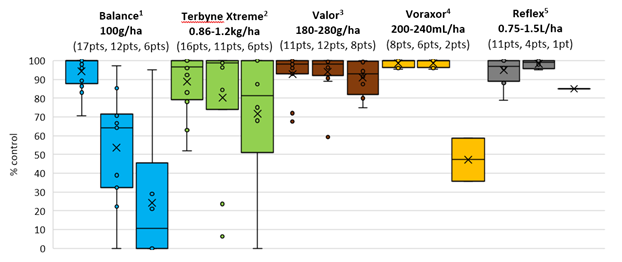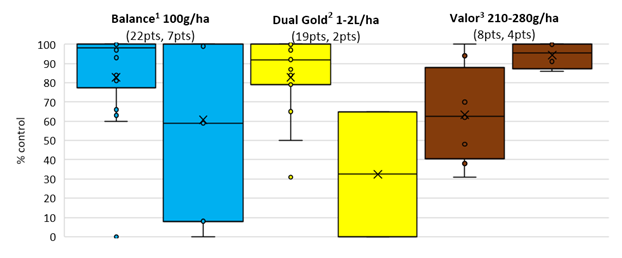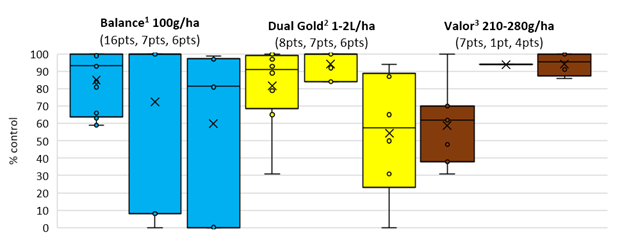Impact of application interval and total rainfall on residual herbicide efficacy
Impact of application interval and total rainfall on residual herbicide efficacy
Author: Linda Bailey (Northern Grower Alliance), Rachel Norton (NGA), Denielle Smith (NGA), Lawrie Price (NGA), Richard Daniel (NGA) | Date: 29 Feb 2024
Take home message
- Multi-year data sets were analysed to examine the residual efficacy of key herbicides on common sowthistle or feathertop Rhodes grass
- Efficacy patterns clearly varied by herbicide and weed species
- The efficacy patterns observed could assist to refine herbicide management choices on the basis of seasonal forecasts.
Background
Validation of the benefit and fit of residual herbicides in the northern farming system has been an important aspect of Northern Grower Alliance (NGA) project activity over many seasons. Individual projects always have a specific research question and focus with the key outcomes being determined generally over a one to two season period.
However, after generating large numbers of efficacy data sets, questions were raised whether additional insights into the use and performance of residual herbicides could be gained by analysing these multi-year data packages.
Summaries were prepared of all NGA trials (in both crop and fallow situations) using residual herbicides to manage three major weed issues: common sowthistle, feathertop Rhodes grass and flaxleaf fleabane. Weed control was expressed as a % of untreated to allow summaries across trials. Data sets were sorted on the basis of the interval from application to assessment and also the total rainfall amount from application to assessment. The intention was to examine the relative impact of application interval and rainfall on herbicide efficacy.
During analysis it was evident that the number of residual flaxleaf fleabane trials (9 trials over 5 cropping seasons) was too small to allow evaluation of application interval or total rainfall impacts.
Key limitation
- Simple comparisons of herbicide efficacy on a product to product basis are not valid due to the wide range of trials and situations evaluated e.g. could be comparing efficacy in summer fallows to winter in-crop.
- Key focus should be on the impact of time from spray application to weed assessment or total rainfall on the performance of the individual herbicide and comparison of those patterns between herbicides.
Common sowthistle (Sonchus oleraceus)
Trials were conducted in a maximum of 16 cropping seasons (8 in both ‘winter’ and ‘summer’). Summaries prepared from a maximum of 35 individual trials (24 in fallow and 11 in chickpeas). Additional efficacy assessments were conducted in 4 fallow trials on multiple weed cohorts.
Table 1. Key herbicides with registrations for residual control of common sowthistle in-crop or fallow that have been included in the data sets following
Herbicide | Crop registrations | Fallow# registration for ‘residual’ use patterns |
|---|---|---|
Isoxaflutole 750g/kg (Balance®) | Post sow pre-emergent (PSPE): chickpeas 100g/ha | 100 g/ha |
Terbuthylazine 850g/kg (Terbyne® Xtreme®) | Pre sowing: chickpeas, field peas, faba beans, lupins 0.86-1.2 kg/ha PSPE: chickpeas, field peas, faba beans 0.6-0.86 kg/ha | 0.86-1.2 kg/ha |
Flumioxazin 500g/kg (Valor®) | Incorporated by sowing (IBS): chickpeas, field peas, faba beans 180 g/ha (Suppression only) IBS: wheat (not durum) 120 g/ha (suppression only) Pre sowing: soybeans, peanuts 210-280 g/ha PSPE: soybeans, peanuts 210 g/ha >1 month pre-sowing: pigeon pea, maize, sorghum, navybean 210-280 g/ha >2 months pre-sowing: cotton, sunflower, mungbeans 210-280 g/ha | 210-280 g/ha |
Saflufenacil 250g/L + trifludimoxazin 125g/L (Voraxor®) | IBS to 7 days pre-sowing: chickpeas, field peas, faba beans, wheat, barley, durum, oats, triticale 200 mL/ha 7-21 days pre-sowing: wheat, barley, durum, oats or triticale 240 mL/ha | Fallow claims on label are only for knockdown |
Fomesafen 240g/L (Reflex®) | IBS: chickpeas, field peas, faba beans, narrow leaf lupins, vetch 750-1500 mL/ha PSPE: chickpeas, field peas, faba beans, narrow leaf lupins 500-1250 mL/ha | n/a |
# Observe plantback requirements for following crops when used in fallow n/a - no registration for use
Figure 1 shows the impact of the time from spray application to weed assessment on common sowthistle control. Efficacy data was initially grouped in intervals of <10 weeks, 10-14 weeks, 14-18 weeks and >18 weeks (not shown). However, grouping in periods of <14 weeks and >14 weeks showed very similar efficacy patterns but ensured larger data sets in each category.

Figure 1. Box and whisker analysis showing the impact of application interval on residual control of common sowthistle.
For each herbicide, the left-hand column shows efficacy in assessments with <14 week intervals, right-hand >14 weeks from application
Text under the herbicide shows the number of data points for each application interval scenario e.g. 23 observations for Isoxaflutole (Balance) <14 weeks, 12 observations >14 weeks
Where herbicide rate ranges are shown, no clear rate differences were evident in the data sets
Limited data exists for saflufenacil+ trifludimoxazin (Voraxor) and fomesafen (Reflex) with evaluation only commencing summer 2021/22. Take care with interpretation as these herbicides may not have been compared across the same range of environmental conditions.
Horizontal line in each box shows the median result with ‘X’ showing the mean. Where the median line is well above the mean, it indicates a distribution with skewed frequency to higher levels of control e.g. terbuthylazine (Terbyne Xtreme) at >14 weeks. Where the median line is well below the mean, it indicates a distribution with skewed frequency to lower levels of control e.g. isoxaflutole (Balance) >14 weeks. Range is shown by whiskers with outliers as individual dots.
1 750g/kg isoxaflutole, 2 875g/kg terbuthylazine, 3 500g/kg flumioxazin, 4 250g/L saflufenacil, + 125g/L trifludimoxazin, 5 240g/L fomesafe
Figure 2 shows the impact of the total rainfall between application and assessment on common sowthistle efficacy. The efficacy data is grouped in three scenarios; <150mm rainfall between application and assessment, 150-300mm rainfall and >300mm rainfall. NB analysis was only possible on the total amount of rainfall received as there were insufficient trials to assess the impact of different rainfall distributions.
Figure 2. Box and whisker analysis showing the impact of total rainfall on residual control of common sowthistle.
For each herbicide the left-hand column shows efficacy in assessments with <150mm rainfall, centre 150-300mm and right-hand >300mm.
The text under the herbicide shows the number of data points for each rainfall scenario e.g. 17 observations for Balance <150mm, 12 observations with 150-300mm and 6 observations with >300mm.
Where herbicide rate ranges are shown, no clear rate differences were evident in the data sets.
Limited data for saflufenacil+ trifludimoxazin (Voraxor) and fomesafen (Reflex) with evaluation only commencing summer 2021/22. Take care with interpretation as these herbicides may not have been compared across the same range of environmental conditions
Horizontal line in box shows the median result with ‘X’ showing the mean. Where the median line is well above the mean, it indicates a distribution with skewed frequency to higher levels of control e.g.. terbuthylazine (Terbyne Xtreme) at 150-300mm. Where the median line is well below the mean, it indicates a distribution with skewed frequency to lower levels of control e.g. isoxaflutole (Balance) >300mm. Range is shown by whiskers with outliers as individual dots.
1 750g/kg isoxaflutole, 2 875g/kg terbuthylazine, 3 500g/kg flumioxazin, 4 250g/L saflufenacil, + 125g/L trifludimoxazin, 5 240g/L fomesafe
Key points - common sowthistle efficacy
Isoxaflutole (Balance) efficacy appeared more impacted by rainfall amount than application interval. High levels of control at <150mm rainfall but generally dropped dramatically in trials with >150mm of rainfall. The most sensitive herbicide to rainfall amount in these data sets.
Terbuthylazine (Terbyne Xtreme) efficacy was generally good but with some results that were unexplained by application interval or rainfall amount alone e.g. 99-100% control was still achieved in 50% of trials >14 weeks after application or >150mm rainfall, however in other situations there had been almost full degradation. Soil type, pH, organic matter and history of triazine herbicide use are other factors also known to influence degradation, however these were not evaluated in this review.
Flumioxazin (Valor) efficacy was generally maintained in both long application intervals or increased rainfall situations, although there was evidence of some degradation at the longest intervals or heavier rainfalls. No clear rate responses. Strong option to consider particularly in fallow when a wet season is forecast.
Saflufenacil+trifludimoxazin (Voraxor) and fomesafen (Reflex) limited data sets but very encouraging results from both herbicides for duration and consistency of control, even in situations with up to 150-300mm.
Feathertop Rhodes grass (Chloris virgata)
Trials were conducted across a maximum of 10 cropping seasons (3 in ‘winter’ and 7 in ‘summer’). Summaries prepared from a maximum of 20 individual trials (18 in fallow and 2 in chickpeas). Additional efficacy assessments were conducted in 6 fallow and 2 chickpea trials on multiple weed cohorts.
Table 2. Key herbicides with registrations for residual control of feathertop Rhodes grass in-crop or fallow that have been included in the data sets following
Herbicide | Crop registrations | Fallow# registration for ‘residual’ use patterns |
|---|---|---|
Isoxaflutole 750g/kg (Balance) | n/a | 100 g/ha |
s-metolachlor 960g/L (Dual Gold®) | Pre sowing: maize, mungbeans, peanuts, soybeans, sunflowers, sorghum 1-2 L/ha Pre sowing: cotton 1L/ha Pre sowing: green bean, navybean 1.5-2 L/ha | 1-2 L/ha |
Flumioxazin 500g/kg (Valor) | Pre sowing: soybeans, peanuts 210-280 g/ha PSPE: soybeans, peanuts 210 g/ha>1 month pre-sowing: pigeon pea, maize, sorghum, navybean 210-280 g/ha >2 months pre-sowing: cotton, sunflower, mungbeans 210-280 g/ha | 210-280 g/ha |
# Observe plantback requirements for following crops when used in fallow n/a - no registration for use
Figure 3 shows the impact of the time from spray application to weed assessment on feathertop Rhodes grass efficacy. Efficacy data was initially grouped in intervals of <10 weeks, 10-14 weeks, 14-18 weeks and >18 weeks (not shown). However, grouping in periods of <14 weeks and >14 weeks showed very similar efficacy patterns but ensured larger data sets in each category.
Figure 3. Box and whisker analysis showing the impact of application interval on residual control of feathertop Rhodes grass.
For each herbicide, the left-hand column shows efficacy in assessments with <14 week intervals, right-hand >14 weeks from application.
Text under the herbicide shows the number of data points for each application interval scenario e.g. 22 observations for isoxaflutole (Balance) <14 weeks, 7 observations >14 weeks.
Where herbicide rate ranges are shown, no clear rate differences were evident in the data sets.
Horizontal line in box shows the median result with ‘X’ showing the mean. Where the median line is well above the mean, it indicates a distribution with skewed frequency to higher levels of control e.g. isoxaflutole (Balance) at <14 weeks (>99% control in 11 of 22 situations). Where the median line is well below the mean, it indicates a distribution with skewed frequency to lower levels of control. Range is shown by whiskers with outliers as individual dots.
1 750g/kg isoxaflutole, 2 s-metolachlor 960g/L, 3 500g/kg flumioxazin
Figure 4 shows the impact of the total rainfall between application and assessment on feathertop Rhodes grass efficacy. The efficacy data is grouped in three scenarios; <150mm rainfall between application and assessment, 150-300mm rainfall and >300mm rainfall. NB analysis was only possible on the total amount of rainfall received as there were insufficient trials to assess the impact of different rainfall distributions.
Figure 4. Box and whisker analysis showing the impact of total rainfall on residual control of feathertop Rhodes grass.
For each herbicide the left-hand column shows efficacy in assessments with <150mm rainfall, centre 150-300mm and right-hand >300mm.
The text under the herbicide shows the number of data points for each rainfall scenario e.g. 16 observations for Balance <150mm, 7 observations with 150-300mm and 6 observations with >300mm.
Where herbicide rate ranges are shown, no clear rate differences were evident in the data sets.
Horizontal line in box shows the median result with ‘X’ showing the mean. Where the median line is well above the mean, it indicates a distribution with skewed frequency to higher levels of control e.g isoxaflutole (Balance) at 150-300mm (100% control in 5 of 7 situations). Where the median line is well below the mean, it indicates a distribution with skewed frequency to lower levels of control. Range is shown by whiskers with probable outliers as individual dots.
1 750g/kg isoxaflutole, 2 s-metolachlor 960g/L, 3 500g/kg flumioxazin
Key points – feathertop Rhodes grass efficacy
Isoxaflutole (Balance) provided effective control in situations with <150mm rainfall or up to 14 weeks from application. Efficacy was generally good even in situations with 150-300mm rainfall (100% control in 5 of 7 trials, but very poor in 2 trials). Feathertop Rhodes grass efficacy appeared less sensitive to rainfall quantity than common sowthistle.
s-metolachlor (Dual Gold) patterns of control were similar to isoxaflutole (Balance) with good efficacy at <14 week intervals. Results in 150-300m rainfall situations were surprisingly good (100% control in 4 of 7 sites).
Flumioxazin (Valor) showed some variability in control at sites that wasn’t explained by application interval or rainfall amount. There was little apparent reduction in efficacy at sites with >150mm rainfall.
Conclusions
The availability of these large data sets allowed evaluation of the impact of the interval between application and assessment, or the amount of rainfall received up to assessment. The interval between application and assessment alone was generally a poor indicator of the residual herbicide efficacy. Amount of rainfall received provided a better indication of herbicide performance but was strongly associated with the individual herbicide and the weed target.
Differences in herbicide performance under varied application intervals or amounts of rainfall could assist growers to better match herbicide choice to the situation of use e.g. modifying management choice on the basis of timing of fallow spraying or on the basis of the season forecast.
Further analysis of trials where variability in efficacy appeared unrelated to either application interval or amount of rainfall is also likely to improve our understanding of how to achieve improved management.
Contact details
Richard Daniel
Northern Grower Alliance
PO Box 78, Harlaxton, QLD 4350
M: 0428 657 782
Email: richard.daniel@nga.org.au
Date published
February 2024
® Registered Trademark
GRDC Project Code: NGA1507-001RTX, NGA2009-001RTX,
